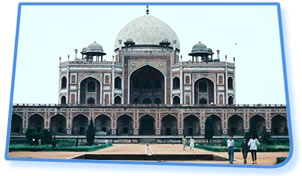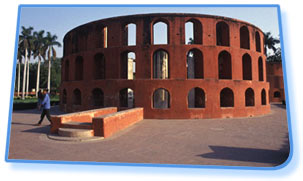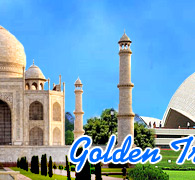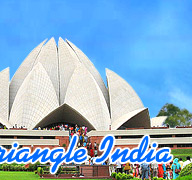 Privileged
to be assigned as a World Heritage site by UNESCO, this tomb was
believed to be designed by Haji Begum, Humayun's Persian widow in the
mid 16th century, shortly after his death in 1556. The tomb was an
important predecessor of Mughal mausoleums. The 'Garden Tomb' as it is
popularly called, is set amidst a geometrically planned garden with a
number of water channels crisscrossing it. Typically, a Persian garden
that would later be seen in the Red Fort of Delhi and Taj Mahal of Agra,
its architectural form and especially its main chamber bears familiarity
with the tomb of the Mongol Ilkhanid ruler of Persia, Oljeytu, at
Sultaniyya, which in turn was influenced by Timurid architecture of the
tomb of Timur (Tamerlane) in Samarkand, the lineage of Babur.
Privileged
to be assigned as a World Heritage site by UNESCO, this tomb was
believed to be designed by Haji Begum, Humayun's Persian widow in the
mid 16th century, shortly after his death in 1556. The tomb was an
important predecessor of Mughal mausoleums. The 'Garden Tomb' as it is
popularly called, is set amidst a geometrically planned garden with a
number of water channels crisscrossing it. Typically, a Persian garden
that would later be seen in the Red Fort of Delhi and Taj Mahal of Agra,
its architectural form and especially its main chamber bears familiarity
with the tomb of the Mongol Ilkhanid ruler of Persia, Oljeytu, at
Sultaniyya, which in turn was influenced by Timurid architecture of the
tomb of Timur (Tamerlane) in Samarkand, the lineage of Babur. The first Indian building to use the Persian double dome, Humayun's tomb is harmonious in its proportions and has some impressions of Indian architecture that are clearly visible in the small kiosks or chhatris on the roof. The building has beautiful inlaid tile work and intricately carved stone screens.
India Gate:
Every Indian heart swells with pride and patriotism as it beholds this beloved gateway, which witnesses the Republic Day parade every year on 26th January, where the latest advancements in military artillery is shown to the public as soldiers and school children march in groups with beaming and bright faces illumined by the love for their motherland. The parade also has decorated vehilcles that glimpses from all the states and union territories of the country, called 'Jhankis'. Straight down the road from Rashtrapati Bhavan, India Gate is a famous war memorial at the east end of Rajpath. Edward Lutyens designed this 42 m high gate structure in memory of the thousands of Indians who sacrificed their lives in World War I. Today, an eternal flame is lit under the gate known as Amar Jawan Jyoti, to honor the unknown soldiers and the martyrs who lost their lives in the Pakistan war of 1971.
Qutab Minar:
To the south of Delhi, the tallest structure of its time, Qutub Minar is 72.5 m in height and has a mosque at the base. It is a magnificent structure whose construction started in 1199 by a Muslim King Qutab-ud-din Aibak (after whom it was named) and was finished by his heir IItutmish. There is an iron pillar standing proudly in front of it since 5th century and has not rusted till yet! It is said that if one hugs this Iron Pillar of Mehrauli and wish for something, it is granted. Unfortunately, the authorities had to disallow tourists from climbing to its top because of several suicide attempts that came into light here. However, there are so many ruins of the ancient times surrounding the area complete with the myths and legends to them that it is quite enjoyable to take a walk around in its premises.
Jantar Mantar:
 If
the large masonry structures in Jantar Mantar appear abstract and do not
appeal to the first sight of the fine art lovers, be not deceived.
Jantar Mantar is far way from being a modern art gallery. It is an
observatory built on the blueprints of Raja Sawai Jai Singh II of Jaipur
(1699-1743) who was an honored noble in the Mughal court during the
times of Aurungzeb. It was said that the erroreneous brass and metal
astronomical instruments of those times dissatisfied Sawai Jai Singh who
was a keen astronomer. After ensuring the safety of his kingdom by
shaking hands with the mighty Mughals, he turned his attention to
correcting the existing astronomical tables and contemporarize the
almanac with more reliable instruments.
If
the large masonry structures in Jantar Mantar appear abstract and do not
appeal to the first sight of the fine art lovers, be not deceived.
Jantar Mantar is far way from being a modern art gallery. It is an
observatory built on the blueprints of Raja Sawai Jai Singh II of Jaipur
(1699-1743) who was an honored noble in the Mughal court during the
times of Aurungzeb. It was said that the erroreneous brass and metal
astronomical instruments of those times dissatisfied Sawai Jai Singh who
was a keen astronomer. After ensuring the safety of his kingdom by
shaking hands with the mighty Mughals, he turned his attention to
correcting the existing astronomical tables and contemporarize the
almanac with more reliable instruments. Delhi's Jantar Mantar is the first of the five observatories, the others being in Jaipur, Varanasi, Ujjain and Mathura. The Samrat Yantra is actually a simple equal hour sun dial, the Ram Yantra was used for reading altitudinal angles, Jai Prakash Yantra ascertained the position of the sun and other celestial bodies in the skies, while the Misra Yantra was a combination of four scientific gadgets.
Rashtrapati Bhavan:
Situated near the circular building of the Parliament House, Rashtrapati Bhavan is the place where the first man of the Nation lives. The official residence of the President of India was once used as the official residence of the Viceroys stationed in India during the British Raj. Edward Lutyens designed this palatial complex. Cream and red-colored sandstones and diverse varieties of marble have been used in its construction. This extensive mansion has 340 rooms, 35 lobbies, vast expanses of well-maintained gardens and 37 fountains to boast of, and is certainly, the pride of India. Though the entry to this massive structure is naturally restricted, the famous Mughal Gardens (which is perhaps the best botanical garden of India and houses thousands of rare varieties of trees, shrubs yielding some of the most captivating flowers and fruits) are opened for public viewing for sometime from the end of February to the middle of March.
Red Fort:
 A
must visit for all the visitors to Delhi, Red Fort or Lal Qila is a
massive red sandstone structure built on the shores of River Yamuna.
Shah Jahan built it with a vision of shifting his capital from Agra to
Delhi. It was completed in 1648 and has two main entrances - Delhi Gate
and Lahori Gate. Lahori Gate of the Red Fort opens up to the so-famous
Chandni Chowk market. Besides its rich archeology museum, the places
worth seeing in this vast fort are Diwan-e-Am, the court where the king
heard public grievances and Diwan-e-Khas ('khas' means 'special'), which
was meant for important visitors of the king. There is not-worth-a-miss
'Sound and Light Show' held here every evening in both Hindi and English
languages, which retells the history of Delhi and mesmerize the guests
with the beautiful performances.
A
must visit for all the visitors to Delhi, Red Fort or Lal Qila is a
massive red sandstone structure built on the shores of River Yamuna.
Shah Jahan built it with a vision of shifting his capital from Agra to
Delhi. It was completed in 1648 and has two main entrances - Delhi Gate
and Lahori Gate. Lahori Gate of the Red Fort opens up to the so-famous
Chandni Chowk market. Besides its rich archeology museum, the places
worth seeing in this vast fort are Diwan-e-Am, the court where the king
heard public grievances and Diwan-e-Khas ('khas' means 'special'), which
was meant for important visitors of the king. There is not-worth-a-miss
'Sound and Light Show' held here every evening in both Hindi and English
languages, which retells the history of Delhi and mesmerize the guests
with the beautiful performances.Raj Ghat:
A pilgrimage to all the patriotic Indians, this place was where the Father of The nation, Mahatama Gandhi, was cremated after his assassination in 1948. It consists of a simple square platform with the words 'Hey Ram' written on it. People come here and offer flowers at the place as a tribute to the great apostle of peace buried here. There is a Gandhi Memorial Museum nearby, where once can see and buy books and tapes containing the writings, speeches and memories of Gandhiji. A short distance to the north of Raj Ghat is Shanti Vana where Jawaharlal Nehru, the first Prime Minister of India, his daugher Indira Gandhi, who herself was a prominent figure in Indian politics and is till now the first and only women Prime Minister of India and her two sons, Rajiv (also the beloved Prime Minister) and Sanjay, were cremated.
Purana Qila or Old Fort:
From the recent excavations near this fort, archaeological evidences such as pottery have been found which throws a new light on the existence of the city of Indraprastha at this place, as mentioned in the great epic of Mahabharata. Sher Shah Suri built the fort and completed it in 1545. However, he soon lost it to the Mughal emperor Humayun, who made good use of the octagonal red sandstone tower known as 'Sher Mandal' as his library and observatory. It is rumored that Humayun slipped from the second storey steps and met his death here. There is a dainty small lake in its premises, where one can enjoy boat rides during summers.












